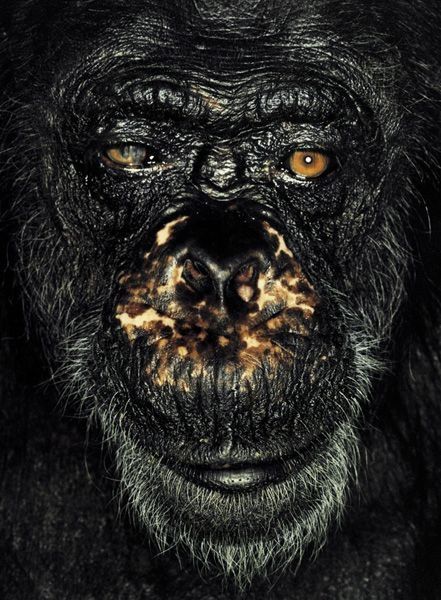|
|
Ape Portrait
|
Biology
The gibbon family, Hylobatidae, is composed of fifteen medium-sized species. Their major distinction is their long arms, which they use to brachiate through the trees. As an evolutionary adaptation to this arboreal lifestyle, their wrists are ball and socket joints. The largest of the gibbons, the Siamang, weighs up to 14 kg (31 lb). In comparison, the smallest great ape is the Common Chimpanzee at a modest 40 to 65 kg (88 to 143 lb).
The great ape family was previously referred to as Pongidae, and humans (and fossil hominids) were omitted from it, but there is no biological case for doing this. This definition is still used by many anthropologists and by lay people; however, it makes Pongidae paraphyletic, whereas most taxonomists nowadays encourage monophyletic groups. Chimpanzees, gorillas, humans and orangutans are all more closely related to one another than any of these four genera are to the gibbons. However, the term "hominid" is still used with the specific meaning of extinct animals more closely related to humans than the other great apes (for example, australopithecines), even though "hominin" is now correct in that usage. It is now usual to use even finer divisions, such as subfamilies and tribes to distinguish which hominoids are being discussed. Current evidence implies that humans share a common, extinct, ancestor with the chimpanzee line, from which we separated more recently than the gorilla line.
Both great apes and lesser apes fall within Catarrhini, which also includes the Old World monkeys of Africa and Eurasia. Within this group, both families of apes can be distinguished from these monkeys by the number of cusps on their molars (apes have five—the "Y-5" molar pattern, Old World monkeys have only four in a bilophodont pattern). Apes have more mobile shoulder joints and arms due to the dorsal position of the scapula, broad ribcages that are flatter front-to-back, and a shorter, less mobile spine compared to Old World monkeys (with caudal vertebrae greatly reduced, resulting in tail loss in some species). These are all anatomical adaptations to vertical hanging and swinging locomotion (brachiation) in the apes, as well as better balance in a bipedal pose. All living members of the Hylobatidae and Hominidae are tailless, and humans can therefore accurately be referred to as bipedal apes. However, there are also primates in other families that lack tails, and at least one (the Pig-Tailed Langur) that has been known to walk significant distances bipedally. The front skull is characterised by its sinuses, fusion of the frontal bone and post-orbital constriction.
|
|









